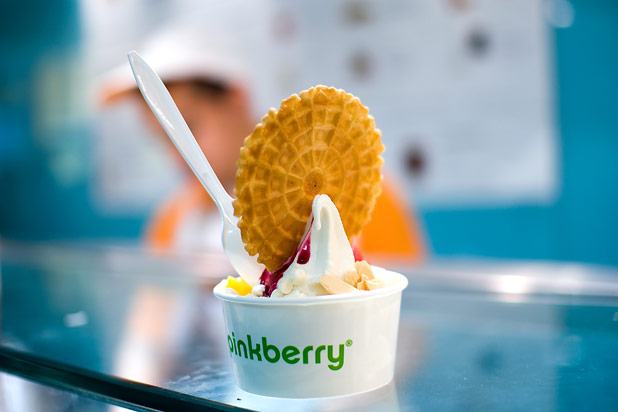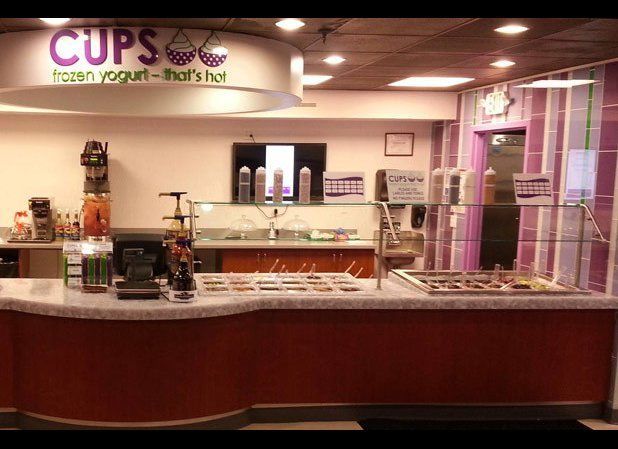 Steamy summer days draw us in hordes to frozen yogurt shops, beseeching us to clamor at the dispensers for cool, delicious relief. While ice cream shops have been around for well more than 100 years, frozen yogurt shops are a newer phenomenon and have been spreading like wildfire recently, inviting us to serve ourselves but raising questions along the way. Is it real yogurt that's being frozen? Is it another form of ice cream? Is it healthier than ice cream and other frozen desserts? With chains allowing you to serve yourself and choose from sometimes dozens of toppings, it's certainly a fun and interactive dessert that you can personalize, but what's behind all of the flavor and topping madness, and ultimately, which chain is the best? We took a look at 10 national frozen yogurt chains to see what they're made of, and the truth is that not all frozen yogurt is the same (Credit: flickr_pamlau).
Steamy summer days draw us in hordes to frozen yogurt shops, beseeching us to clamor at the dispensers for cool, delicious relief. While ice cream shops have been around for well more than 100 years, frozen yogurt shops are a newer phenomenon and have been spreading like wildfire recently, inviting us to serve ourselves but raising questions along the way. Is it real yogurt that's being frozen? Is it another form of ice cream? Is it healthier than ice cream and other frozen desserts? With chains allowing you to serve yourself and choose from sometimes dozens of toppings, it's certainly a fun and interactive dessert that you can personalize, but what's behind all of the flavor and topping madness, and ultimately, which chain is the best? We took a look at 10 national frozen yogurt chains to see what they're made of, and the truth is that not all frozen yogurt is the same (Credit: flickr_pamlau).
Fro-Yo's History
The origins of frozen yogurt go back to around 1970, but its evolution was a long time coming. Ice cream was invented after the first hand-cranked freezer was created and patented in 1848, followed soon after by pasteurization methods and machines in the 1900s. Yogurt slowly gained popularity as a health food through the efforts of Daniel Carasso and of the Danone brand in Europe, and finally Dannon began selling packaged yogurt with fruit on the bottom in the United States in 1942. It took until 1970 to apply the same process of making ice cream to yogurt, wherein the wet and dry ingredients are mixed together, pasteurized, homogenized, and yogurt cultures are added. The result was a healthier, similar-in-consistency treat, but the formula wasn't complete just yet: people complained that it tasted too much like yogurt, was too tart, and not enough like the sweet, creamy ice cream they were used to. Jump to 1981 and you have the opening of the first TCBY in Little Rock, Ark., starting a revolution in the healthier dessert industry.
What Exactly is Fro-Yo?
Despite all the fun flavors and bright colors, fro-yo isn't so simple. To put it in the simplest of terms, it's made from combining milk that's been cultured with live and active cultures with sweetener, a thickening agent, and some sort of flavoring. Then it's pasteurized, fermented, and frozen. Tasti D-Lite, one of the original and longest-standing frozen yogurt chains, claims that they typically use water, nonfat milk, sugar, corn syrup, cream, guar gum, locust bean gum, and carrageenan to make their frozen yogurts. TCBY uses milk that's been cultured with live and active cultures like B. lactis, L. acidophilus, and L. bulgaricus, and in Red Mango's ingredient list you'll find nonfat yogurt that's made with skim milk, natural flavor, guar gum, and live and active cultures, filtered water, pure cane sugar, and other natural flavors. Some chains find loopholes around their ingredients, however: the Food and Drug Administration mandates that to be considered a "yogurt," the product has to have the two bacteria, lactobacillus bulgaricus and streptococcus thermophiles, though it does not say that the bacteria need to be present in the final product. Thus, many frozen yogurt places cannot technically qualify as a "yogurt," but still fall into the niche market of frozen yogurt.
The exact recipe varies from place to place, but in general you're going to find much less fat and much more protein than traditional ice cream. However, when fat is eliminated, typically more sugar is added, but if you pay attention to the serving size, frozen yogurt is a healthy alternative as far as desserts go. On average, in about a 4-ounce serving you'll find about 17 grams of sugar, 100 calories, and 2 grams of fat, depending on the company.
It can be extremely overwhelming walking into a frozen yogurt store, from the bright décor at TCBY to the club music at Cups and the iPads at Let's Yo. Even the flavors can be outrageous, like spicy Aztec chocolate, maple bacon donut, and ginger lemonade. You typically want to try it all and end up with a $7 hodge-podge of yogurt and toppings, so hopefully our test can help sort things out for you.
The Daily Meal's Ranking
In order to assemble our ranking, we looked at each of 10 popular fro-yo chains in a few categories to see how they matched up. At each of the chains, we aimed to sample a chocolate, vanilla, fruit, and classic tart/original flavor, but had to make adjustments at a few locations due to availability of flavors. We looked at them in seven categories and ranked them in each from one to five, one being the weakest/worst/not a lot, and five being the highest/best/a lot. Price was also taken into consideration.
10 Chains were tested and each place had a different atmosphere, delivered a different experience, and had different flavors to offer. At many of the chains, there were flavors offered that had (apparently) nuances of difference in taste, like chocolate, Dutch chocolate, dark chocolate, and chocolate malt, or even strawberry, wild strawberry, Sonoma strawberry, and strawberries and cream. All this fiddling with semantics might seem unnecessary, but every yogurt chain is trying to outdo its competition as frozen yogurt becomes more and more popular and seemingly less of just a fad. Hopefully this testing can help provide a baseline of what makes a frozen yogurt shop's offerings delicious, fun, and a relatively healthier alternative to traditional ice cream.
If you're looking to keep frozen yogurt as healthy as possible no matter where you're getting it from, some nutritionists and professionals chime in on the topic. Dawn Jackson Blatner, R.D., told Glamour that you should add large fruits to make the cup look fuller, and add toppings with volume, like cereal or other things with air in them to take up room. Cynthia Sass, M.P.H, R.D., and author of S.A.S.S! Yourself Skinny, added that you should include a little bit of your favorite topping to satiate your sweet craving, and Alyse Levine, M.S., R.D., at Nutritionbite out of Los Angeles, says not to fill the entire cup, because they're typically sized to hold two to three times the amount you should be having. And if you're just looking for something sweet and don't care all that much about the best flavor and toppings, obviously go for the option that has the least calories, sugar, and fat to get your sweet fix.
- Katie Reinhard, The Daily Meal
More from The Daily Meal:
Delicious Homemade Yogurt Recipes
Healthy Frozen Treats
19 Ice Creams You've Never Heard Of
How to Make a Perfect Banana Split
